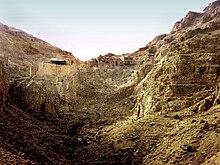Dair Mar Musa al-Habaschi

The Christian monastery of Dair Mār Mūsā al-Habaschi ( Arabic دير مار موسى الحبشي, DMG Dair Mār Mūsā al-Ḥabašī 'Monastery of St. Moses of Abyssinia') rises on a ledge in a narrow wadi on the slopes of the Antilebanon Mountains in Syria . It stands on the site and on the foundation walls of a watchtower that was still built by the Romans . After a long vacancy, it was revived at the end of the 20th century as a place of dialogue between denominations and religions .
prehistory
The name of the monastery goes back to an Abyssinian prince named Moses , who retired here about 1500 years ago to one of the small caves on the side of the erosion channel in order to lead an ascetic life. As a result, a small group of pious men gathered here for centuries to search for God in the basic monastic virtues in the seclusion of the mountain landscape near -Nebek (about 80 km north of Damascus ). The first documentary mention of a monastery can be found in 586.
The ruins of the small Roman border fortifications were expanded into a small basilica and for a long time was the only building in the monastery; We lived in the surrounding caves. In the 11th and 12th centuries the monastery experienced a strong boom. The church was repeatedly frescoed and the monastery as a whole expanded and fortified. In the 17th century, under the Muslim rule of the area, the ever-small stream of seekers of God tore off and the monastery went under.
revival
In 1982 the Jesuit Father Paolo Dall'Oglio came to Syria from Italy . He turned away from Christian claims to power and sought his calling and dialogue in the country of origin of Christian asceticism. From 1984 he began to rebuild the dilapidated monastery. Initially only supported by volunteers from the area and individual Europeans. An informal living and working community was formed under his leadership.
The historic buildings were soon too small to accommodate. First, a short distance away, using natural caves, an accommodation, known today as Dair el-Huqab , was built for the male monks and the goats of the monastery. The women's shelter Dair el-Hayek , which began in 1998, is still not quite complete , with guest quarters and seminar rooms. The former garage with a generator room, which stood in the valley below the monastery, has now been expanded and now also houses the goat barn and a room for reading masses there.
Since 1991 the informal community has become a recognized monastic community under the auspices of the Syrian Catholic Church . The basic monastic virtues "prayer" (Arabic: salad) and work ('Amal) were expanded by Father Paolo to include the Arabic elements of hospitality (Dayafa) and dialogue (Hiwar). The community has only seven permanent members (2008) and is now open to women (2) and men (5), and there are always volunteers present who lead the lives of the brothers and sisters for a few weeks, but sometimes for months or years share.
A special focus of the work is the ecumenical movement , due to the situation in Syria, especially of Catholic and Orthodox Christians, and the dialogue between Christianity and Islam. For this purpose, the monastery maintains a small library with these focuses.
In addition, based on the efforts of the monastery to provide food for itself, the monastery has developed into a center for organic farming under the conditions of a semi-desert . A national park has also been set up in the vicinity, and the monastery is also involved in the tourist development, but the monastery is dependent on outside funding.
In 2007, two monks from Dair Mar Musa also revived the Dair Mar Elian monastery, about 50 km north of Karjatain .
Web links
- Official website of the monastery
- Deir Mar Moussa (French)
- Christian Fuchs on SPIEGEL ONLINE about Mar Musa
- Beatrix Gramlich: The Taizé des Orients , in: Continents, November / December 2013.
Coordinates: 34 ° 1 ′ 18.2 ″ N , 36 ° 50 ′ 32.4 ″ E

